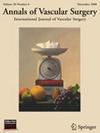Validation of the E-CABG Bleeding Severity Classification in Open Peripheral Arterial Surgery
IF 1.6
4区 医学
Q3 PERIPHERAL VASCULAR DISEASE
引用次数: 0
Abstract
Background
Documentation of perioperative bleeding during vascular procedures is crucial for monitoring efficacy, safety, and to evaluate patient outcomes. This study validated the European Multicenter Study on Coronary Artery Bypass Grafting (E-CABG) bleeding classification for evaluating perioperative bleeding in patients undergoing open peripheral arterial surgery (OPAS).
Methods
Prospective, multicenter cohort study including adult patients undergoing elective OPAS. Patients undergoing abdominal aortic surgery were excluded to maintain a homogeneous bleeding risk profile. Primary outcome was the incidence of complications categorized per E-CABG grade. Logistic regression was used to evaluate the predictive ability of Grade I or higher on patient outcomes. The model was adjusted for type of OPAS to minimize heterogeneity.
Results
A total of 778 patients were included. Ninety-four patients (12%) suffered a bleeding complication (Grade I: n = 47, 6.0%; Grade II: n = 47, 6.0%). Patients suffering Grade ≥ I had significantly more thrombo-embolic complications (TECs) (P < 0.001), myocardial infarction (P = 0.006), bowel ischemia (P < 0.001), graft thrombosis (P = 0.019), graft infection (P = 0.026), wound infection (P < 0.001), pneumonia (P = 0.024), prolonged duration of hospital admission (P < 0.001), higher reoperation (P < 0.001), and mortality (P < 0.001) than patients without a bleeding complication. In a multivariate model, Grade ≥ I predicted 30-day mortality (area under the curve (AUC) 0.81, 95% confidence interval [CI] 0.63–0.96), reoperation other than bleeding (AUC 0.75, 95% CI 0.66–0.85), wound infection (AUC 0.76, 95% CI 0.72–0.80), and TEC (AUC 0.67, 95% CI 0.58–0.76).
Conclusion
The E-CABG bleeding classification is applicable for stratifying the severity of perioperative bleeding in OPAS and predicting adverse short-term postoperative outcomes for research and registry databases.
开放外周动脉手术中E-CABG出血严重程度分级的验证。
目的:血管手术中围手术期出血的记录对于监测疗效、安全性和评估患者预后至关重要。本研究验证了欧洲冠状动脉旁路移植术(E-CABG)出血分类的多中心研究,用于评估开放性外周动脉手术(OPAS)患者围手术期出血。方法:前瞻性,多中心队列研究,包括选择性OPAS的成年患者。接受腹主动脉手术的患者被排除在外,以保持均匀的出血风险概况。主要结局是按E-CABG分级分类的并发症发生率。使用逻辑回归来评估I级或更高级别对患者预后的预测能力。根据OPAS的类型对模型进行了调整,以尽量减少异质性。结果:共纳入778例患者。94例(12%)患者出现出血并发症(I级:n=47, 6.0%;II级:n=47, 6.0%)。≥1级的患者血栓栓塞并发症(TEC)明显增加(p结论:E-CABG出血分级适用于对OPAS围手术期出血严重程度进行分层,并可用于研究和登记数据库预测术后短期不良结局。
本文章由计算机程序翻译,如有差异,请以英文原文为准。
求助全文
约1分钟内获得全文
求助全文
来源期刊
CiteScore
3.00
自引率
13.30%
发文量
603
审稿时长
50 days
期刊介绍:
Annals of Vascular Surgery, published eight times a year, invites original manuscripts reporting clinical and experimental work in vascular surgery for peer review. Articles may be submitted for the following sections of the journal:
Clinical Research (reports of clinical series, new drug or medical device trials)
Basic Science Research (new investigations, experimental work)
Case Reports (reports on a limited series of patients)
General Reviews (scholarly review of the existing literature on a relevant topic)
Developments in Endovascular and Endoscopic Surgery
Selected Techniques (technical maneuvers)
Historical Notes (interesting vignettes from the early days of vascular surgery)
Editorials/Correspondence

 求助内容:
求助内容: 应助结果提醒方式:
应助结果提醒方式:


